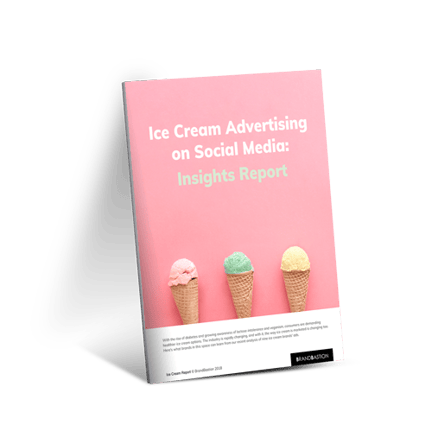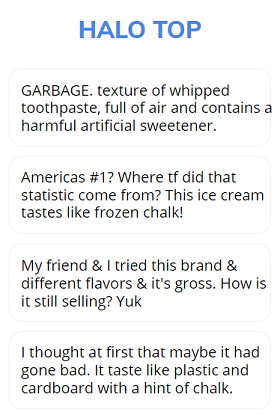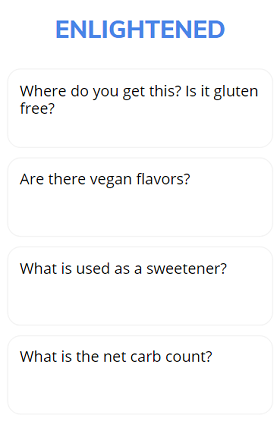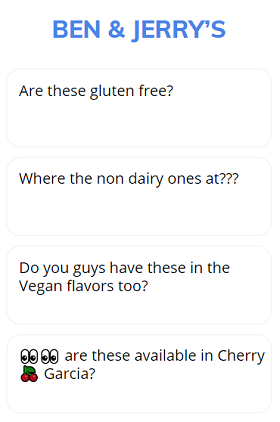REPORT
Ice Cream Advertising on Social Media: What You Need to Know
The industry is rapidly changing, and with it, the way ice cream is marketed is changing too. Here's what brands in this space can learn from our recent analysis of nine ice cream brands' ads.
Download Free Report
Highlights
∣ For the ice cream category, positive experiences with the product itself are what drives the overwhelming majority of positive comments on brands’ ads.
∣ Negative comments are focused on a mixture of products perceived to be poor quality and advertising creative that is perceived as distasteful.
∣ The majority of comments categorized as customer
Ice Cream: A Rapidly-Transforming Industry
Fun, carefree, indulgent, playful - these are some of the words that
Globally, the ice cream market in 2016 was valued as a $54.80 billion industry. Despite growing health consciousness worldwide, the ice cream market is expected to continue growing at a CAGR of 4.1% between 2018 to 2025.
Although there is an expected decline in ice cream consumption in North America and Europe, this will be offset by growing demand in the Asia-Pacific, Latin America, and
Ice cream producers are also attempting to stop the decline in traditional ice cream consumption by pandering to increasing demand for healthier options. Most major brands including Häagen-Dazs and Ben & Jerry’s have introduced dairy-free and vegan options to fend off new market entrants like Halo Top, Outshine, and ENLIGHTENED which have been quickly stealing away market share.
Research suggests that the demand for non-dairy ice cream is set to triple between 2017 - 2024. These alternative plant-based ice creams are usually made from soy, almond, and coconut milk and were created in response to a variety of factors, such as:
- Asia’s diabetes crisis which currently affects over 6% of the adult population in the region fueling demand for sugar-free ice cream, and
- Europe’s growing interest in veganism as a lifestyle, with over 9% of the population being vegans, leading to a surge in demand for non-dairy ice cream.
An entire industry is in the process of being completely transformed, from the way it is marketed to its entire supply chain from sourcing to production.
With this in mind, and as summer holidays are just around the corner, the team at BrandBastion thought it would be great to dig into our bank of ice cream ads to see what we could learn.
Read on to see what ice cream brands can learn about efficiently managing comments on ads!

The Analysis
We analyzed 5,390 comments across nine ice cream ads posted between May 2017 to May 2018 on Instagram. The ads were from nine different brands including Häagen-Dazs, Ben & Jerry's, Dreyers, Talenti gelato, Magnum, Breyers, Halo Top, Outshine, and ENLIGHTENED.
Seven out of the nine ads analyzed had a "Learn More" call-to-action leading the viewer to product pages with more information when clicked on. Two ads had no CTA at all, although CTAs are an effective way to drive action and conversions.
Want a similar analysis like this for your campaigns? Click here to get started!
Top 3 Brands For Positive Comments
The top three brands with the highest percentage of positive comments received on their ads (out of all comments received) were Häagen-Dazs (32.8% positive), Talenti Gelato (32.0%), and Magnum (30.0%). The average percentage of positive comments for all nine brands analyzed was 28.0%.
The positive comments for all three brands’ ads were predominantly about the product itself. People who had tried the flavors being featured in the ad were posting glowing reviews about how good it was and tagging their friends in the comments as well.
TAKEAWAY #1: Happy customers increase an ad's reachHaving a good product and keeping customers satisfied increases the ROI of your social spend and extends the reach of campaigns, as users spread the ad’s reach organically by tagging their friends in the comments feed and recommending them to try the product.
Here’s a sampling of some of the comments that these three brands received:



Top 3 Brands For Negative Comments
The top three brands with the highest percentage of negative comments received on their ads (out of all comments received)
The negative comments for Dreyers were focused on the health aspects of Dreyers’ “half-fat” ice cream being promoted in the ad - calling it deceptive marketing. Meanwhile, Halo Top, marketed as America’s #1 ice cream brand and as a healthier option to traditional ice cream, had a significant volume of negative comments saying the ice cream was “chalky” and “tasteless”.
For Ben & Jerry’s, however, the negative comments were not about the ice cream, but rather about the ad creative. The video used in the ad for coffee-flavored ice cream showed coffee beans on a table that were vibrating or “buzzing”, while the caption read: “Get
Get buzzed! New Coffee, Coffee BuzzBuzzBuzz Pint Slices now available.
A post shared by Ben & Jerry's (@benandjerrys) on
This example is a good reminder that a brilliant creative idea may not work for a social + mobile format. Marketing teams often review ad creatives on large screens in the comfort of an office, while users tend to scroll through ads on tiny mobile screens, glancing at them for barely a second. So while Ben & Jerry’s intended to communicate a vibe of energy and excitement with their Coffee BuzzBuzzBuzz ad, they did the opposite by turning users off and leaving them disgusted.
TAKEAWAY #2: Listen to what your customers have to say
The feedback from the comments thread contains valuable tips for future improvement and helps you spot technical issues about ads that you may not have known otherwise.
Here’s a sampling of some of the comments that these three brands received:



Ads With The Most Engagement
Overall, Unilever’s Breyers ad garnered the most engagement with 1,615 comments and Dreyers the least with 29 comments. (Note: This does not take into account the varying reach of the ads and the varying ad spend.)
The ad for Breyers advertised a low-calorie ice cream with the caption “Amazingly delicious ice cream at 310-330 calories per pint. Go on enjoy. Indulge without all the guilt.”
While the ad still generated a significant volume of negative comments (62 negative comments), the critics of low-calorie ice cream were drowned out by the overwhelmingly positive comments (410 positive comments). While there is much skepticism towards ice cream marketed as “healthy” and consumers tend to perceive it as bland, tasteless, or scammy, Breyers’ customers seem to genuinely enjoy their product for its taste.
Customers left comments such as “those are so much better than halo top and enlighten. they taste just like real ice cream not like frozen protein shake” and “Thank you for making my little girl happy. The
A post shared by Breyers (@breyers) on
Customer Inquiries
In addition to positive and negative sentiment, we looked at which ads had the most customer service queries in the ad comments. We found that high-protein, low-sugar ice cream brand ENLIGHTENED had the highest ratio of queries to overall comments (15.6%), followed by Ben & Jerry’s (6.8%) and Halo Top (6.5%). The average ratio across all nine brands was 6.1%.
On ENLIGHTENED and Ben & Jerry's ads, people were mostly asking about the health aspects of the ice cream - for instance, whether it was gluten-free and vegan, and what types of sweeteners were used. Most of the queries on ENLIGHTENED’s ads were responded to, whereas for Ben & Jerry’s, these users did not receive any replies. Given that Ben & Jerry’s does offer non-dairy options, these unanswered customer inquiries were missed opportunities to start conversations with customers about these alternatives.
TAKEAWAY #3: Cross-sell organically by replying to questions people are asking in the comment thread
Promoting products does not only have to be done directly through awareness campaigns. Cross-selling can take place organically, at a low cost, in the comments section where people are asking about your products.
For Halo Top, the engagement varied slightly - it appeared that many customers were not able to find the flavor being advertised and as such were flooding the comment feed with frustrated feedback and questions. Such comments are an indication that there is a communication gap between marketing and distribution - leading to unhappy customers.
At BrandBastion, we commonly see this gap in many ads we analyze, from apparel and fashion to food products to FMCG goods. Often, products are unintentionally advertised
TAKEAWAY #4: Improve ad performance by closing the feedback gap between distribution and marketing
One simple way to stop wasting precious ad dollars and creating frustration and resentment among customers is to close the feedback gap between distribution and marketing.
To drive better customer engagement, Halo Top should not advertise to customers in regions where specific flavors are not sold, or, actively respond to queries about where to get the advertised flavor. At the time of this report, no customer inquiry had received a response.




Other Types of Engagement
Aside from measuring sentiment and customer queries, we found that on average, 2.3% of all comments in the ads analyzed were references to competitors’ products. These comments usually promote a competitor brand as better than the brand being advertised. At 4.7%, Breyers had the highest percentage of comments that promoted competitors’ products.
TAKEAWAY #5: Listen and moderate actively
Active social listening and moderation can significantly reduce the volume of competitor promotions, toilet humor, spam, brand attacks, and other types of harmful comments.
We also observed a small percentage of negative comments being related to health issues (0.3%), toilet humor (0.3%), spam (0.7%), and brand attacks (0.4%).



Recap of takeaways
TAKEAWAY #1: Happy customers increase an ad's reach
Having a good product and keeping customers satisfied increases the ROI of your social spend and extends the reach of campaigns, as users spread the ad’s reach organically by tagging their friends in the comments feed and recommending them to try the product.
TAKEAWAY #2: Listen to what your customers have to say
The feedback from the comments thread contains valuable tips for future improvement and helps you spot technical issues about ads that you may not have known otherwise.
TAKEAWAY #3: Cross-sell organically by replying to questions people are asking in the comment thread
Promoting products does not only have to be done directly through awareness campaigns. Cross-selling can take place organically, at a low cost, in the comments section where people are asking about your products.
TAKEAWAY #4: Improve ad performance by closing the feedback gap between distribution and marketing
One simple way to stop wasting precious ad dollars and creating frustration and resentment among customers is to close the feedback gap between distribution and marketing.
TAKEAWAY #5: Listen and moderate actively
Active social listening and moderation can significantly reduce the volume of competitor promotions, toilet humor, spam, brand attacks, and other types of harmful comments.
Our technology uses neural networks, natural language processing and machine learning for content processing. Our content processing system processes all comments and takes actions based on pre-configured guidelines. Our trained teams of quality assurance managers and content processing specialists oversee the processes ensuring we have the highest level of accuracy.
Limitations:
- This analysis mainly focuses on the most popular ice cream brands
- We analyzed only publicly visible comments
- Topics identified are based on current context and can change over time
